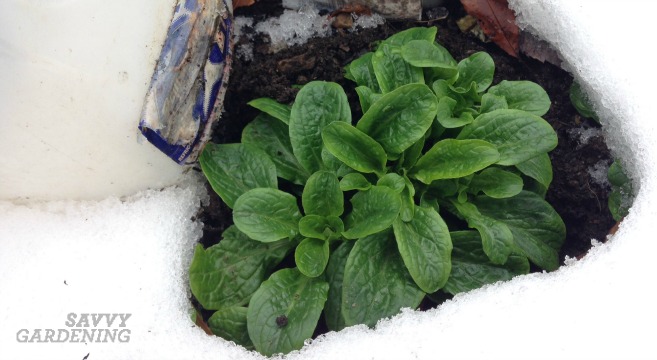This post may contain affiliate links. If you make a purchase through links on our site, we may earn a commission.
I paid a visit to my winter vegetable garden over the weekend and discovered that one of my favorite cold-weather crops, corn mache, was still cranking out the green. While most of my winter vegetable garden was decimated by the deer, these delicious, succulent greens were safely tucked under the protection of milk jug cloches. I couldn’t have been happier to see those little green sprouts surrounded by the snow. Needless to say, I snipped off a few leaves and enjoyed them in my dinner salad.
Why corn mache is a staple the winter vegetable garden
Corn mache, also called corn salad and lamb’s lettuce, is one of the most cold-tolerant vegetables you can grow, making it a perfect choice for the winter vegetable garden. It’s tough as nails but delivers a sweet, nutty flavor to the salad bowl.
How to grow corn mache
To grow it, I sow seeds directly into the garden twice a year; first in the very early spring and then again in the fall. The spring-planted crop is ready to harvest about two months after the seeds are sown. I harvest only the outer-most leaves of the plant while leaving the growing point intact to allow for repeat harvests. Once summer temperatures hit, mache shifts into flowering mode and turns bitter. I often allow the plants to flower and set seed because mache easily self-sows.
Come mid-September, I head out to the garden to plant more seeds. The sprouts that grow from these seeds become the mature plants in my winter vegetable garden. When the temperatures really drop, usually in late October or early November, I put a cap-less milk jug, with the bottom cut out, over each one of the plants. You could also use a commercially made cloche to cover your plants or even a mini plastic greenhouse tunnel, if you want something a bit fancier.

As winter arrives, the plants stay cozy inside the cloches. The lettuce and arugula I had under separate cloches died off after a few nights with single digit temperatures, but not the corn mache.
Types of corn mache
There are many different varieties of corn mache, each with a subtly different flavor and form. I’ve grown several different types over the years and have developed a preference for the extremely cold-tolerant varieties such as ‘Big Seeded’ and ‘Gala’.
How to eat corn mache
Corn mache is an excellent salad green that can be eaten just like lettuce, arugula, or mesclun. Its thick, succulent texture really fills up the salad bowl and blends beautifully with other salad greens.
If you’re looking for an addition to your winter vegetable garden, give corn mache a try.
For more on growing winter veggies, check out these articles:
- Three quick steps to winter carrots
- Growing salad mustard
- Cold frame gardening tips
- Edible sunflower microgreens

What’s growing in your garden this winter?




I have heard of corn salad and am looking forward to trying it.
What city are you near, to give an idea of the climate you are dealing with. I am in the midwest, Lincoln NE area
I’m in Pennsylvania, zone 5.
I wish I can plant in my unheated 12′ x 20′ greenhouse all winter long! I’m in West Central Alberta Zone 2A and as soon as the cold reaches negative 2 digits everything freezes inside the greenhouse. We tried putting a wood stove just to plant some winter greens but it is not enough to warm the whole greenhouse so we just gave up!
Eliot Coleman’s books on winter gardening are certainly worth a look, as are YouTube videos by One Yard Revolution. Both feature a variety of winter crops hardy down to -25 F outside by using multiple layers of row cover over winter crops (both spun fabric and sheet plastic) inside a high-tunnel hoop house.